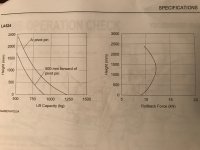You were right to guess 40mm.
Here are the measurements I took tonight.
The relief pressure was listed in the manual.
I ran a few calcs (on the right) but I'm not sure where to go from there with calculating the forces.
It's been a few years since my statics and dynamics classes in college and I'm afraid I've forgotten a lot of it. :-/
Thanks for the help!
View attachment 596632
The first step is figuring the angle in which the cylinder's force is applied.
This isnt the angle with the ground, or any particular point that is easily measured. Thus the triangle measurements is all aI need. Knowing the Lengths of the 3 sides I can calculate the exact angle. (look up law of cosines for formula)
So we want to focus on triangle BDC, and in particular...we need to solve for angle B. And then EDC (when raised) to again find the angle of the cylinder
Law of cosines is a PITA to actually type out. I'll trust you can apply the numbers on your own and solve for angle B and E when raised? if not I can attempt to spell it out.
I come up with
21.08 degrees when lowered and
15.3 degrees at full raise.
________________________________________________________________________________
Step 2....Find the force of the cylinder.
40mm bore @ 2205psi = 4295 pounds of push force PER cylinder.
But cylinder mounted on an angle. To account for that, the vertical component of the lift force is the Sine of the angle.
So. Sin(21.08) x 4295 pounds x 2 cylinders =
3090 pounds vertical force
....Sin(15.3) x 4295 x 2 =
2266 pounds vertical force at max lift
_______________________________________________________________________________________________
Step 3: The above is the lift force where the cylinder attaches to the loader. Now we need to figure how that relates to the Pin location
Now it becomes a lever......A-B-C with C the fulcrum, and B where the force is applied......At point A....you have 0.539% of force applied at B.
So at ground level,
1665#
At max height,
1221#
______________________________________________________________________________________________________
Step 4. This is a bit tricky to "actually" measure. Especially without a force gauge. And that is Just how much does the weight of the loader/bucket take away from the capacity? IT can be measured with a pressure gauge and reverse calculated. But given the "spec" is
947# to max height....and the cylinder force NOT accounting for the weight of the bucket/frame is
1221#....I'd say that's pretty close.


